Distributed Dynamic Economic Dispatch of an Isolated AC/DC Hybrid Microgrid Based on a Finite-Step Consensus Algorithm
Abstract
1. Introduction
- A distributed, finite-step consensus algorithm has been proposed for dynamic economic dispatch problem of AC/DC-HMG, which is seldom investigated. Based on our algorithm, the optimal output power of generations in both the AC side and DC side could be obtained in a distributed way.
- Different from other distributed algorithms, our proposed algorithm can be converged to the optimal value in finite steps, which is associated with the communication topology. Therefore, the computation time is effectively reduced.
- Our algorithm is more suitable for AC/DC-HMG containing various distributed generations. The algorithm can efficiently address the features of plug and play, and it can be suitable for communication link failures.
2. Optimal Dispatching Model of AC/DC Hybrid Microgrid
2.1. AC/DC-HMG Structure
2.2. Dynamic ED Model for AC/DC-HMG
2.2.1. Objective Function
2.2.2. Constraints
2.2.3. Karush–Kuhn–Tucker (KKT) Optimal Conditions
3. Finite-Step Consensus Dynamic Economic Dispatch Strategy
3.1. The Overview of Graph Theory
3.2. Finite-Step Consensus Algorithm
3.3. Secondary Adjustment Strategy Based on Virtual Load Value
4. Case Study
4.1. The Global Optimal Plan of Single-Period Analysis
4.2. The Sub-Microgrid Independent Optimal Plan of Single-Period Analysis
5. Conclusions
Author Contributions
Funding
Conflicts of Interest
References
- Hooshyar, A.; Iravani, R. Microgird protection. Proc. IEEE 2017, 105, 1332–1353. [Google Scholar] [CrossRef]
- Liu, X.; Wang, P.; Loh, P. A hybrid AC/DC microgrid and its coordination control. IEEE Trans. Smart Grid 2014, 2, 278–286. [Google Scholar]
- Akinyele, D.; Belikov, J.; Levron, Y. Challenges of microgrids in remote communities: A steep model application. Energies 2018, 11, 432. [Google Scholar] [CrossRef]
- Mohamed, S.; Shaaban, M.F.; Ismail, M.; Serpedin, E.; Qaraqe, K.A. An efficient planning algorithm for hybrid remote microgrids. IEEE Trans. Sustain. Energy 2019, 10, 257–267. [Google Scholar] [CrossRef]
- Aprilia, E.; Meng, K.; Al Hosani, M.; Zeineldin, H.H.; Dong, Z.Y. Unified power flow algorithm for standalone AC/DC hybrid microgrids. IEEE Trans. Smart Grid 2019, 10, 639–649. [Google Scholar] [CrossRef]
- Papari, B.; Edrington, C.; Bhattacharya, I.; Radman, G. Effective energy management of hybrid AC–DC microgrids with storage devices. IEEE Trans. Smart Grid 2019, 10, 193–203. [Google Scholar] [CrossRef]
- Li, Z.; Shahidehpour, M. Small-signal modeling and stability analysis of hybrid AC/DC microgrids. IEEE Trans. Smart Grid 2019, 10, 2080–2095. [Google Scholar] [CrossRef]
- Duan, J.; Yi, Z.; Shi, D.; Lin, C.; Lu, X.; Wang, Z. Reinforcement-learning-based optimal control of hybrid energy storage systems in hybrid AC–DC microgrids. IEEE Trans. Ind. Inform. 2019, 15, 5355–5364. [Google Scholar] [CrossRef]
- Gao, H.; Liu, J.; Wang, L.; Wei, Z. Decentralized energy management for networked microgrids in future distribution systems. IEEE Trans. Power Syst. 2018, 33, 3599–3610. [Google Scholar] [CrossRef]
- Xu, S.; Yan, Z.; Feng, D.; Zhao, X. Decentralized charging control strategy of the electric vehicle aggregator based on augmented Lagrangian method. Int. J. Electr. Power Energy Syst. 2019, 104, 673–679. [Google Scholar] [CrossRef]
- Damousis, I.; Bakirtzis, A.G.; Dokopoulos, P.S. Network-constrained economic dispatch using real-coded genetic algorithm. IEEE Trans. Power Syst. 2003, 18, 198–205. [Google Scholar] [CrossRef]
- Gaing, Z. Particle swarm optimization to solving the economic dispatch considering the generator constraints. IEEE Trans. Power Syst. 2003, 18, 1187–1195. [Google Scholar] [CrossRef]
- Long, H.; Fan, X.; Liu, S. Review of distributed consensus problem in multi-agent system. Comput. Eng. Appl. 2013, 49, 36–42. [Google Scholar]
- Ahmad, J.; Tahir, M.; Mazumder, S. Dynamic economic dispatch and transient control of distributed generators in a microgrid. IEEE Syst. J. 2019, 13, 802–812. [Google Scholar] [CrossRef]
- Chen, G.; Li, C.; Dong, Z. Parallel and distributed computation for dynamical economic dispatch. IEEE Trans. Smart Grid 2016, 8, 1026–1027. [Google Scholar] [CrossRef]
- Han, Y.; Zhang, K.; Li, H. MAS-based distributed coordinated control and optimization in microgrid and microgrid clusters: A comprehensive overview. IEEE Trans. Power Electron. 2018, 33, 6488–6508. [Google Scholar] [CrossRef]
- Wang, R.; Li, Q.; Zhang, B.; Wang, L. Distributed consensus based algorithm for economic dispatch in a microgrid. IEEE Trans. Smart Grid 2019, 10, 3630–3640. [Google Scholar] [CrossRef]
- Zhang, W.; He, X. Stealthy attack detection and solution strategy for consensus-based distributed economic dispatch problem. Int. J. Electr. Power Energy Syst. 2018, 103, 233–246. [Google Scholar] [CrossRef]
- Ross, M.; Abbey, C.; Bouffard, F.; Joos, G. Microgrid economic dispatch with energy storage systems. IEEE Trans. Smart Grid 2018, 9, 3039–3047. [Google Scholar] [CrossRef]
- Yun, H.; Shim, H.; Ahn, H. Initialization-free privacy-guaranteed distributed algorithm for economic dispatch problem. Automatica 2019, 102, 86–93. [Google Scholar] [CrossRef]
- Hamdi, M.; Chaoui, M.; Idoumghar, L.; Kachouri, A. Coordinated consensus for smart grid economic environmental power dispatch with dynamic communication network. IET Gener. Transm. Distrib. 2018, 12, 2603–2613. [Google Scholar] [CrossRef]
- Zhang, Z.; Chow, M. Convergence analysis of the incremental cost consensus algorithm under different communication network topologies in a smart grid. IEEE Trans. Power Syst. 2013, 27, 1761–1768. [Google Scholar] [CrossRef]
- Yang, S.; Tan, S.; Xu, J. Consensus based approach for economic dispatch problem in a smart grid. IEEE Trans. Power Syst. 2013, 28, 4416–4426. [Google Scholar] [CrossRef]
- Xu, Y.; Li, Z. Distributed optimal resource management based on the consensus algorithm in a microgrid. IEEE Trans. Ind. Electron. 2015, 62, 2584–2592. [Google Scholar] [CrossRef]
- Li, B.; Zhang, P.; Li, J.; Cao, X. Distributed absorption and half-search approach for economic dispatch problem in smart grids. Energies 2019, 12, 1527. [Google Scholar] [CrossRef]
- Bai, L.; Sun, C.; Ye, M.; Hu, G. Distributed economic dispatch control via saddle point dynamics and consensus algorithms. IEEE Trans. Control Syst. Technol. 2017, 27, 898–905. [Google Scholar] [CrossRef]
- Liu, Z.; Miao, S.; Fan, Z.; Liu, J.; Tu, Q. Improved power flow control strategy of the hybrid AC/DC microgrid based on VSM. IET Gener. Transm. Distrib. 2019, 12, 81–91. [Google Scholar] [CrossRef]
- Zhai, X.; Wang, N. Multi-agent consensus algorithm-based optimal power dispatch for islanded multi-microgrids. Energies 2019, 7, 679. [Google Scholar]
- Le, L.; Zhou, Q.; Zhao, L.; Wang, Y. Research on the real-time distributed economic dispatch strategy for microgrids. Energies 2019, 12, 4007. [Google Scholar] [CrossRef]
- Li, Y.; Dong, P.; Liu, M.; Yang, G. A distributed coordination control based on finite-time consensus algorithm for a cluster of DC microgrids. IEEE Trans. Power Syst. 2019, 34, 2205–2215. [Google Scholar] [CrossRef]
- Chen, G.; Zhao, Z.; Li, Z. Distributed finite-step iterative algorithm for economic dispatch of generation. IEEE Trans. Ind. Inform. 2018, 14, 5221–5232. [Google Scholar] [CrossRef]

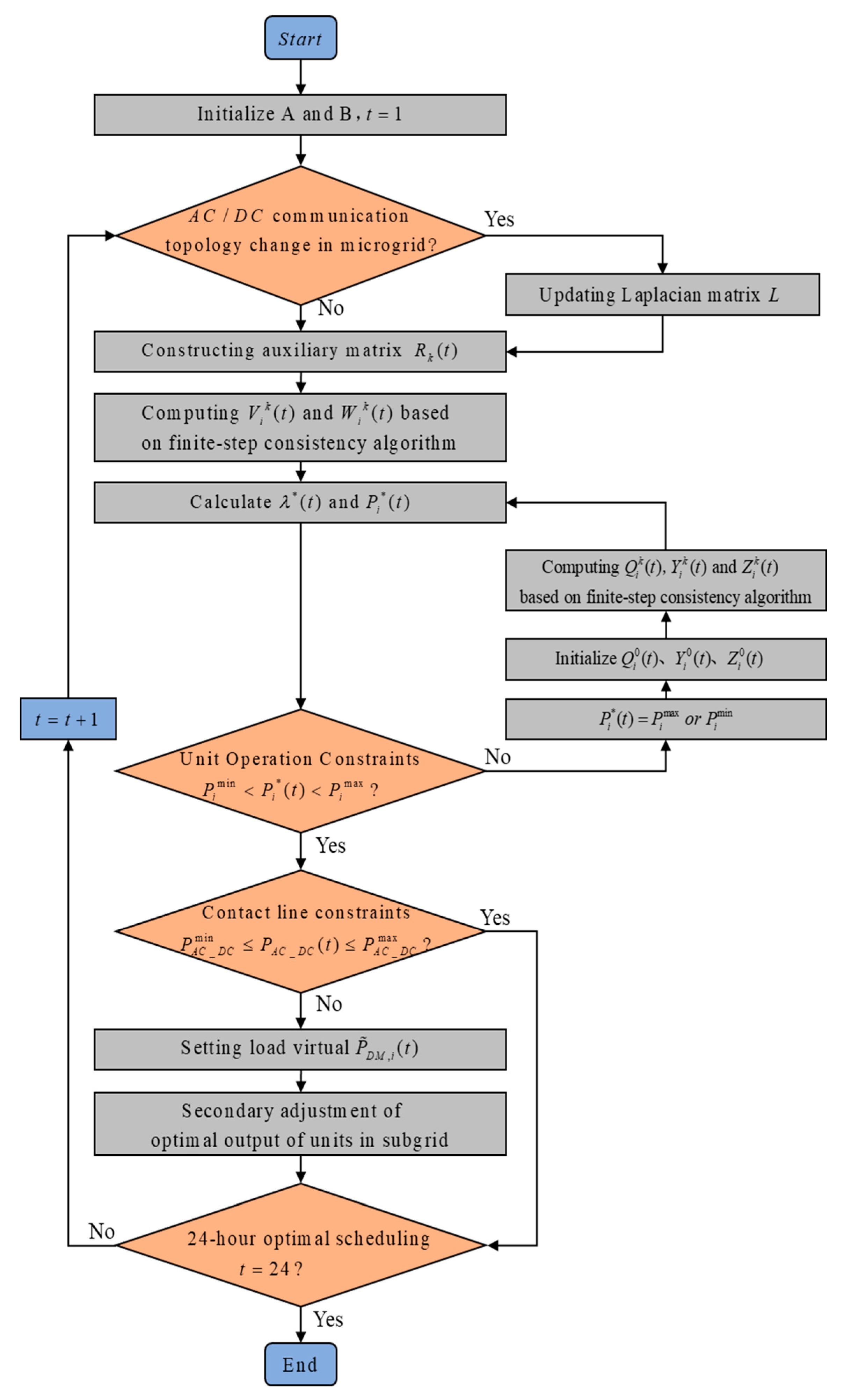


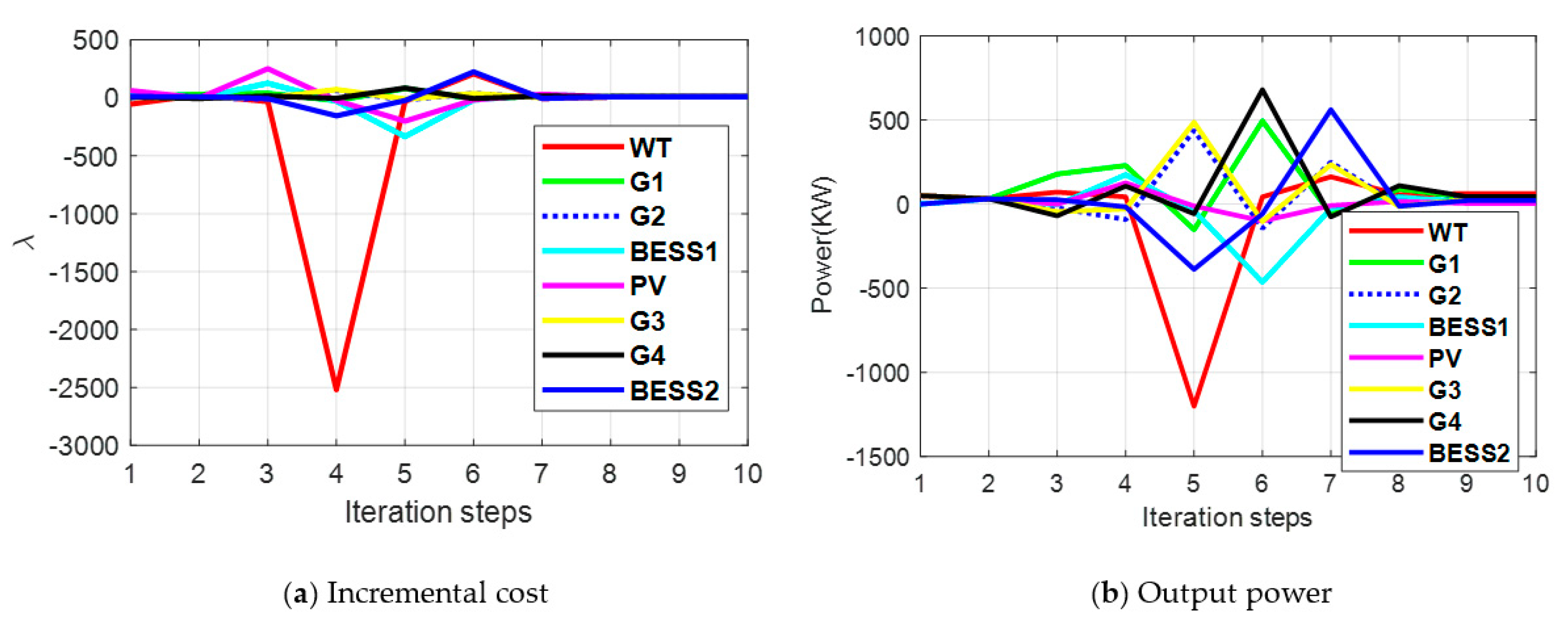
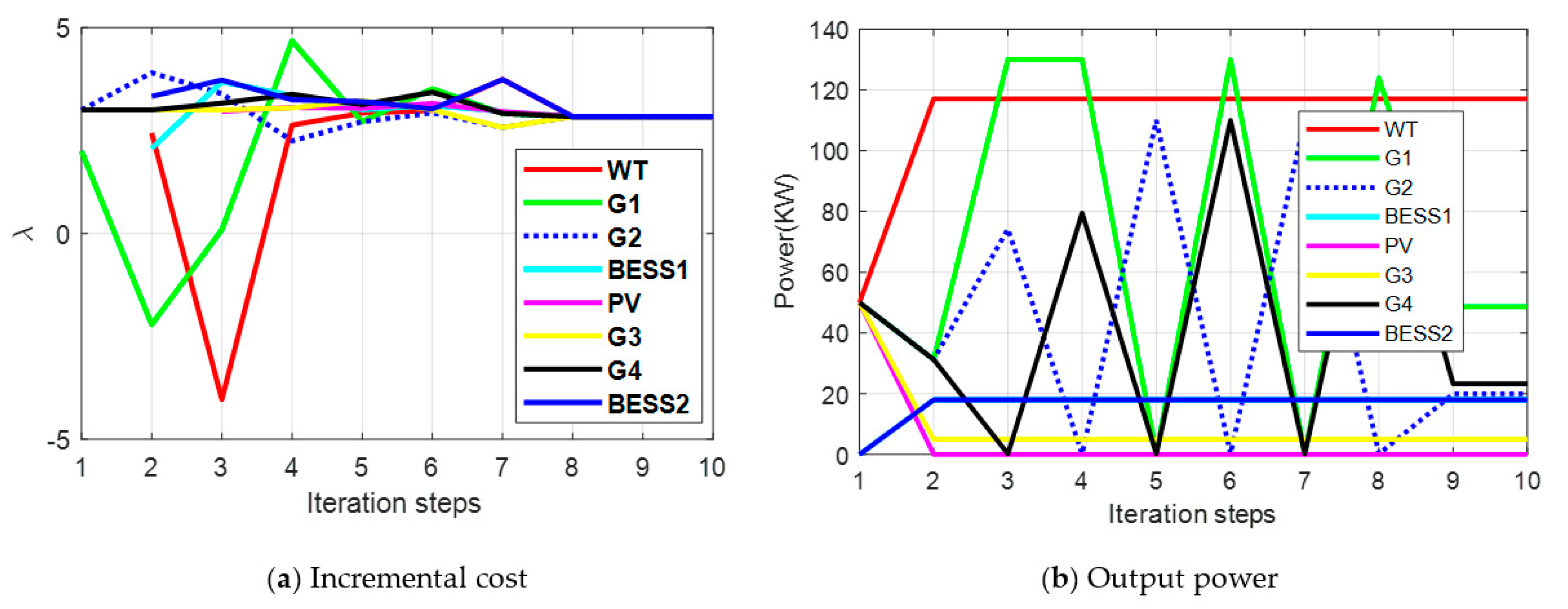
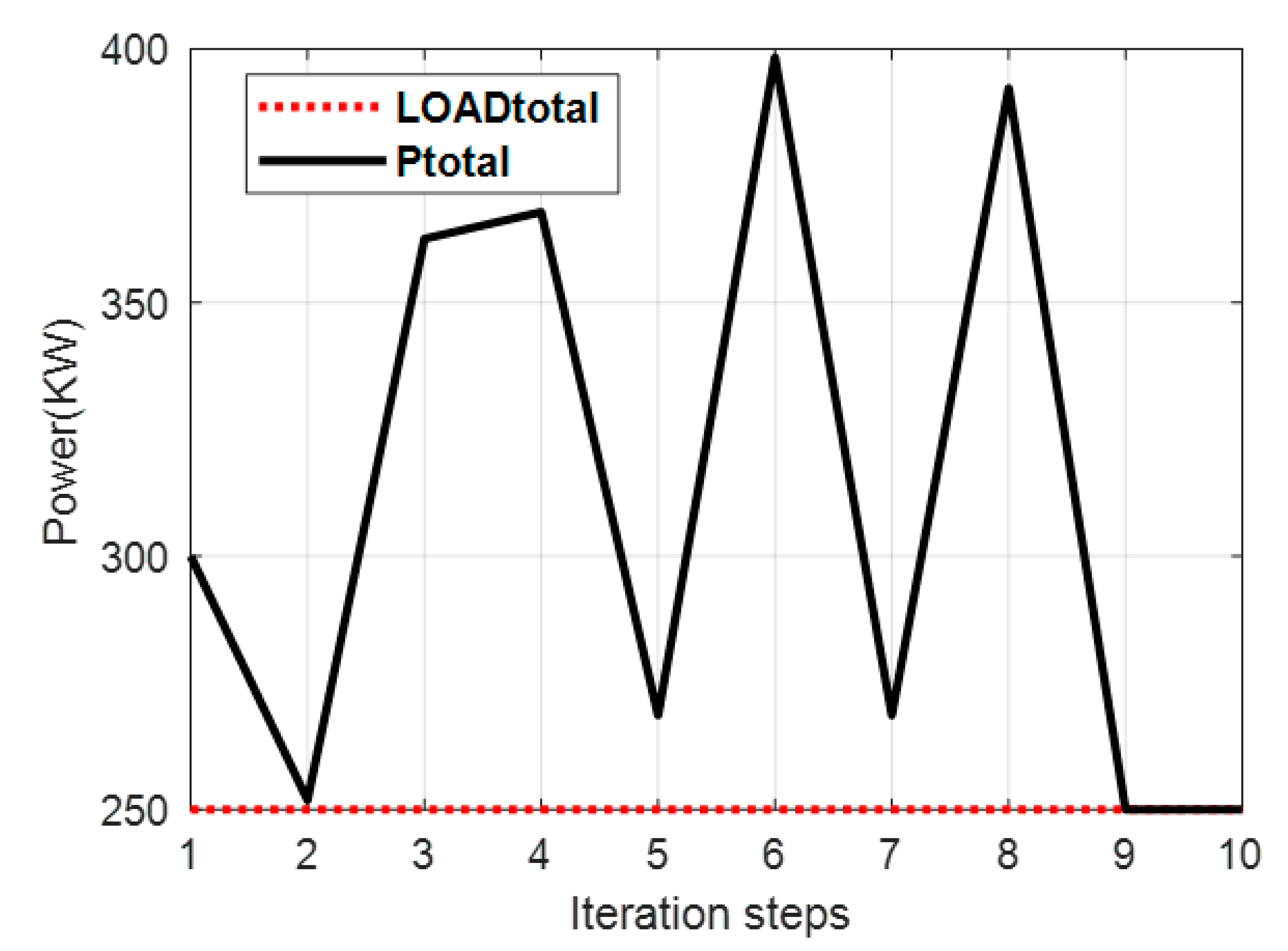

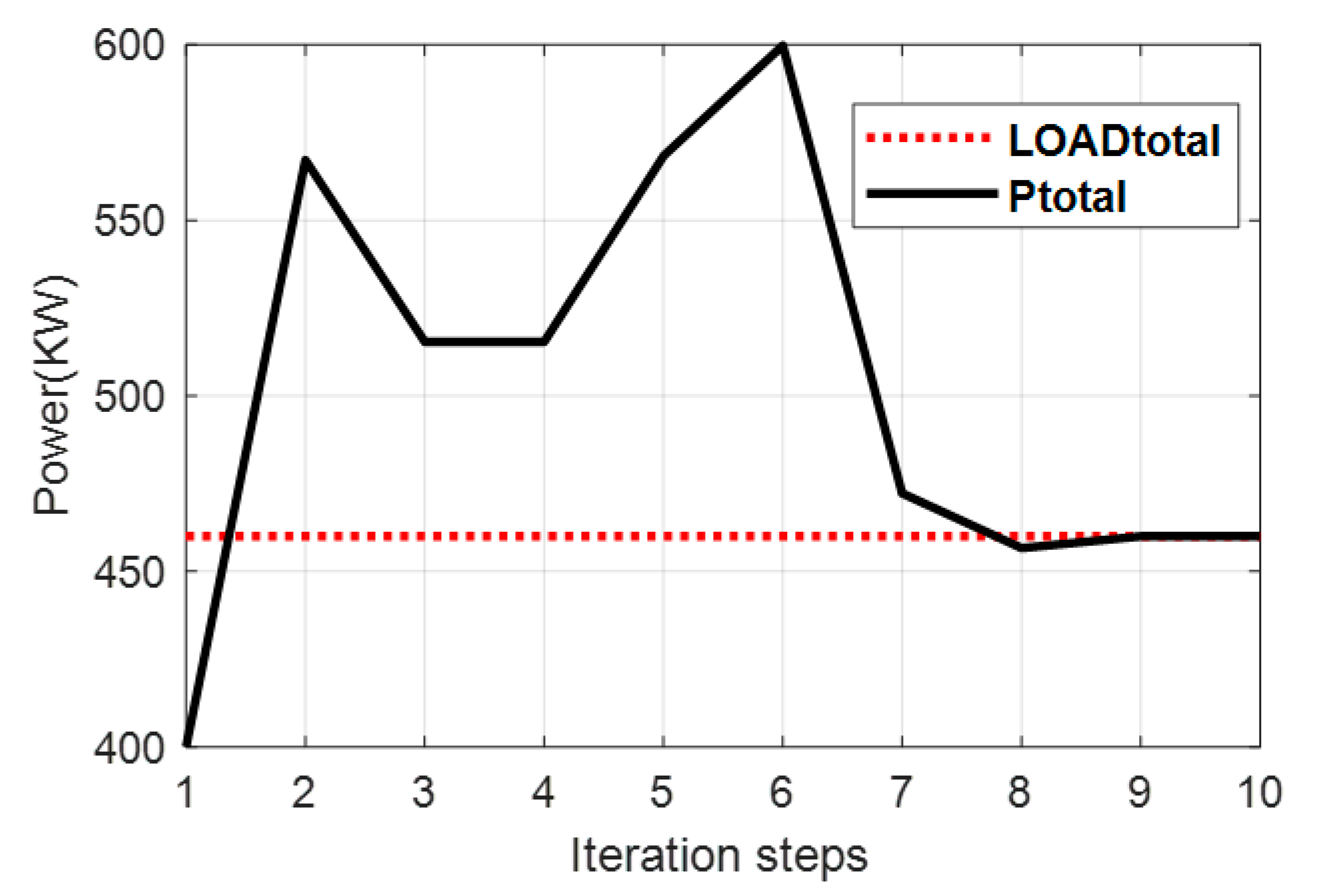
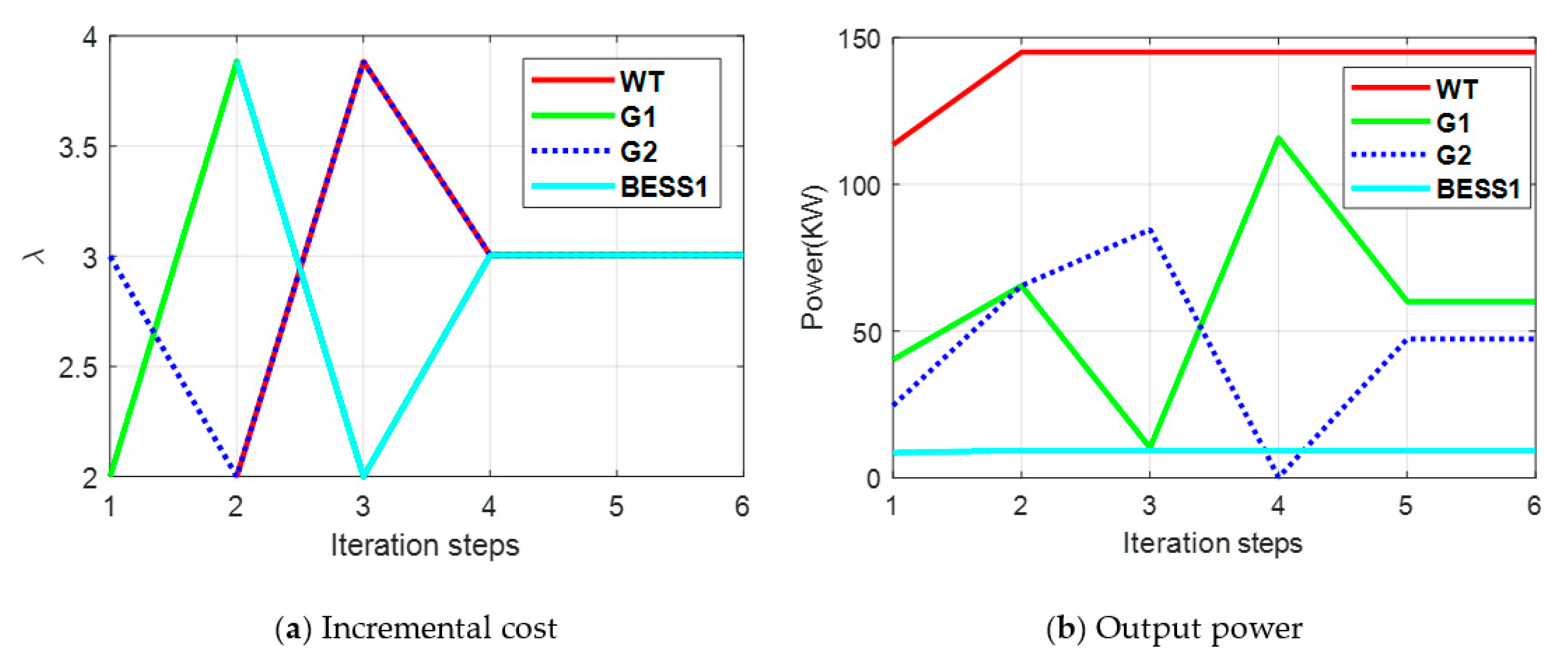


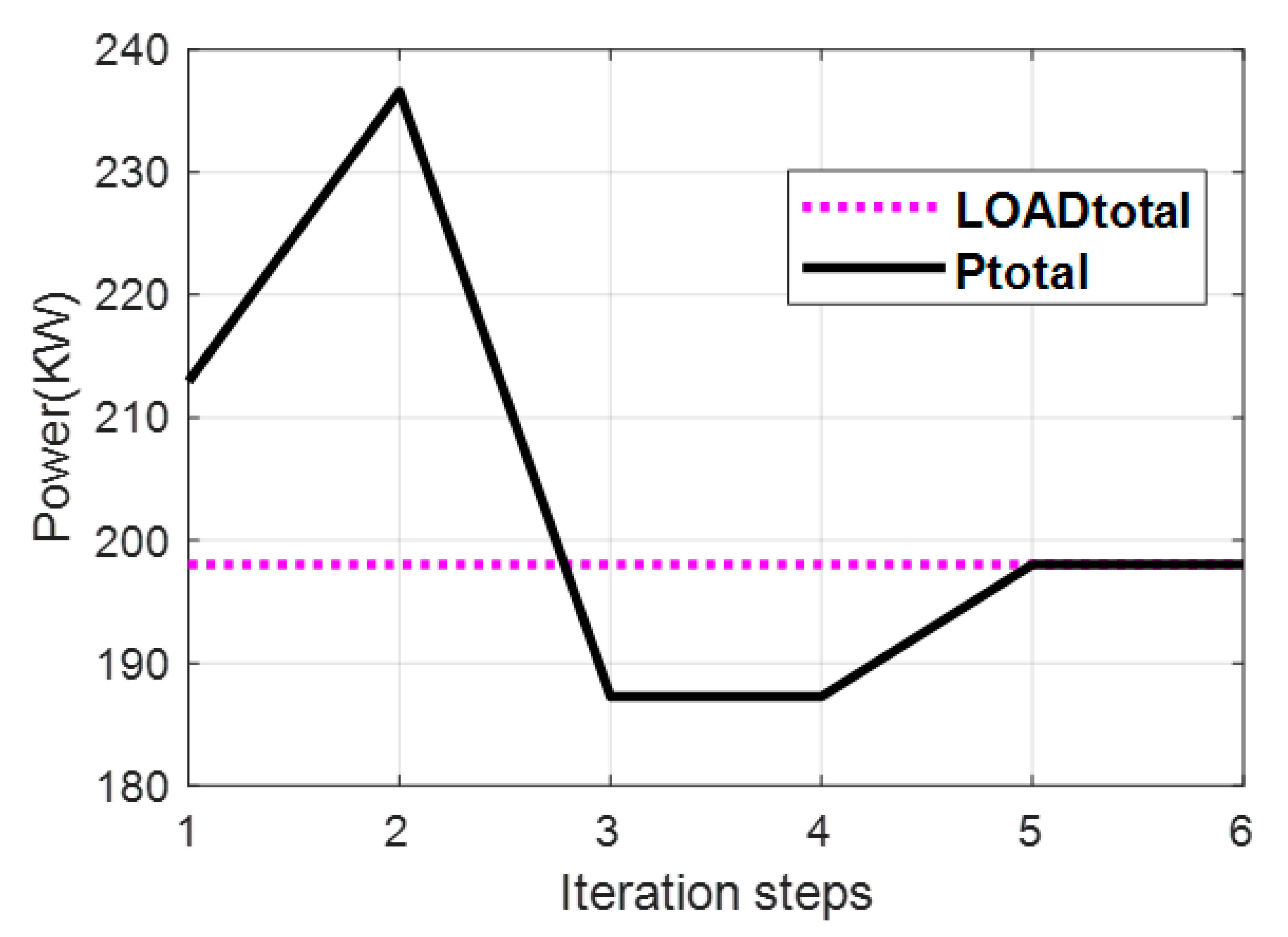
| Time Eriod | Load/kW | PV/kW | WT/kW |
|---|---|---|---|
| 00:00—01:00 | 250 | 0 | 117.120218535654 |
| 01:00—02:00 | 220 | 0 | 121.521251478584 |
| 02:00—03:00 | 190 | 0 | 114.206082843385 |
| 03:00—04:00 | 150 | 0 | 91.9048293624883 |
| 04:00—05:00 | 160 | 0 | 89.0762082204174 |
| 05:00—06:00 | 150 | 0 | 131.614010287532 |
| 06:00—07:00 | 190 | 15 | 81.7427863655850 |
| 07:00—08:00 | 250 | 35 | 131.453977290065 |
| 08:00—09:00 | 350 | 95 | 128.907351493896 |
| 09:00—10:00 | 400 | 130 | 135.226389034385 |
| 10:00—11:00 | 350 | 150 | 100.563661757176 |
| 11:00—12:00 | 400 | 180 | 113.566138886138 |
| 12:00—13:00 | 460 | 170 | 145.089441537814 |
| 13:00—14:00 | 410 | 150 | 94.3964155018810 |
| 14:00—15:00 | 310 | 120 | 56.0018819779476 |
| 15:00—16:00 | 290 | 95 | 136.674989699932 |
| 16:00—17:00 | 300 | 70 | 113.118873426901 |
| 17:00—18:00 | 360 | 50 | 85.5073651878849 |
| 18:00—19:00 | 640 | 10 | 149.700327160665 |
| 19:00—20:00 | 720 | 0 | 72.4171498983127 |
| 20:00—21:00 | 720 | 0 | 115.245107296861 |
| 21:00—22:00 | 600 | 0 | 110.499064190826 |
| 22:00—23:00 | 500 | 0 | 88.7245431483135 |
| 23:00—24:00 | 360 | 0 | 64.2187159290504 |
| No. | Unit | ai | bi | ∆Pi,u (kW/h) | ∆Pi,d (kW/h) | [Pmin,Pmax] (kW) |
|---|---|---|---|---|---|---|
| 1 | WT | 1.00 | — | — | — | [0, —] |
| 2 | G1 | 0.08 | 2 | 80 | 75 | [0.3, 300] |
| 3 | G2 | 0.07 | 3 | 60 | 55 | [0.2, 200] |
| 4 | BESS1 | 0.36 | 0 | [−30, 30] | ||
| 5 | PV | 1.00 | — | — | — | [0, —] |
| 6 | G3 | 0.07 | 4 | 50 | 45 | [0.1, 100] |
| 7 | G4 | 0.06 | 3 | 60 | 55 | [0.2, 200] |
| 8 | BESS2 | 0.20 | 0 | [−60, 60] |
© 2019 by the authors. Licensee MDPI, Basel, Switzerland. This article is an open access article distributed under the terms and conditions of the Creative Commons Attribution (CC BY) license (http://creativecommons.org/licenses/by/4.0/).
Share and Cite
Jiang, K.; Wu, F.; Zong, X.; Shi, L.; Lin, K. Distributed Dynamic Economic Dispatch of an Isolated AC/DC Hybrid Microgrid Based on a Finite-Step Consensus Algorithm. Energies 2019, 12, 4637. https://doi.org/10.3390/en12244637
Jiang K, Wu F, Zong X, Shi L, Lin K. Distributed Dynamic Economic Dispatch of an Isolated AC/DC Hybrid Microgrid Based on a Finite-Step Consensus Algorithm. Energies. 2019; 12(24):4637. https://doi.org/10.3390/en12244637
Chicago/Turabian StyleJiang, Ke, Feng Wu, Xuanjun Zong, Linjun Shi, and Keman Lin. 2019. "Distributed Dynamic Economic Dispatch of an Isolated AC/DC Hybrid Microgrid Based on a Finite-Step Consensus Algorithm" Energies 12, no. 24: 4637. https://doi.org/10.3390/en12244637
APA StyleJiang, K., Wu, F., Zong, X., Shi, L., & Lin, K. (2019). Distributed Dynamic Economic Dispatch of an Isolated AC/DC Hybrid Microgrid Based on a Finite-Step Consensus Algorithm. Energies, 12(24), 4637. https://doi.org/10.3390/en12244637






